Last September, my journey took me to Rome, where I visited the Caracalla Baths. In today's post, I want to share this adventure with you. The magnificent walls that stand out on the large artificial earth embankment are the remains of the once imposing Caracalla Baths complex. Today, despite the destruction caused by the ages, the full majesty of the ancient baths can still be seen.
The Baths of Caracalla were a huge bathing complex in ancient Rome, built by the Emperor Caracalla in the third century AD, and remained in operation until the sixth century, when the Roman Empire collapsed. The Baths are located in the very centre of Rome, about a 20-minute walk from the Colosseum. You won't need more than two hours of your time for a leisurely tour of the baths and the underground section.


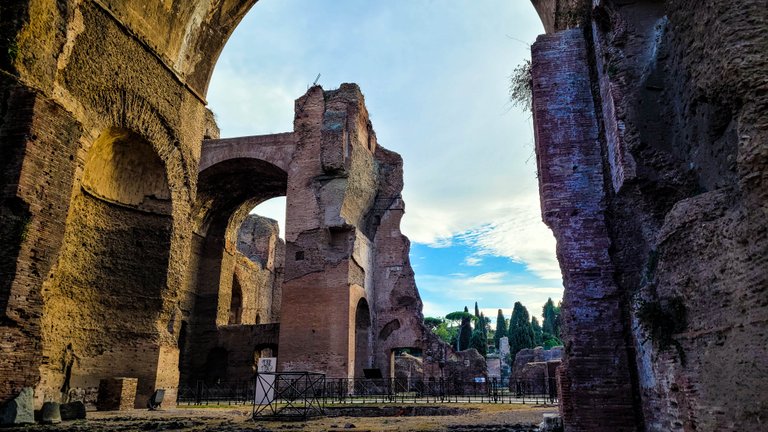
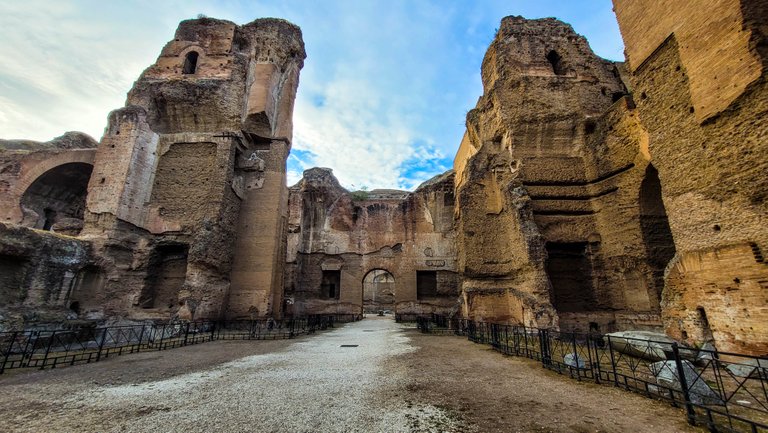
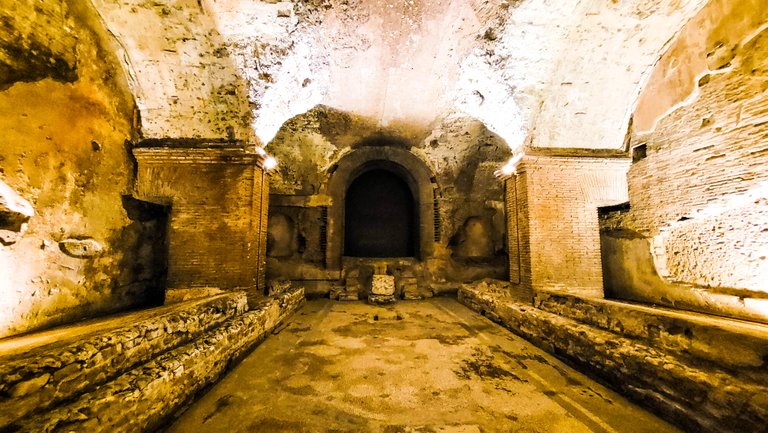
A little bit of history
Historians estimate that the complex could accommodate up to 1,600 visitors at a time, with daily visitors numbering up to 8,000. The spa was built symmetrically. The central building was 220 metres long and 114 metres wide, and reached a height of 37 metres. It was built on two floors and with several levels below ground level. The baths were oriented in a north-south direction to make the best use of sunlight for heating. For the water supply, an aqueduct called L'Acquedotto Antoniniano was built just for this purpose. Without water, there is no spa 😊





The Baths of Caracalla were of great importance to the ancient Romans and were visited by people from all social classes. The baths were the right location for relaxing, socialising with friends and acquaintances and to attend cultural events.

Source: Pinmapple.com
The underground area
Let me present you the baths complex as I’ve visited it, from the bottom up 😊. The underground area of the baths wasn’t inside the walls, but next to them. The entrance is big, so you can't miss it. As soon as you descend the stairs you immediately get a whiff and smell of that time, really exciting. If you are not comfortable in the narrow underground spaces, you don't need to worry here. The underground is very spacious and not at all cramped. The tunnels are 6 metres wide. The area is so vast since served as the service area of the baths. Here all the devices used to heat the water and the air were installed.

Underneath the bath complex there was a small underground city on several levels, with a network of tunnels. Inside the tunnels, they used carts to transport, among other things, the firewood needed for the functioning of the baths themselves. There were also metres and metres of water pipes and ducts for hot air.





A lot of firewood was needed to keep the spa running and to power the heating furnaces that heated the water and the air in the spa rooms. The furnaces were running 24 hours a day. A special legislation of that time imposed that they had to have enough firewood in stock to run the spa for 7 months. Guess how much firewood they used per day…😊 by some calculations as much as 10 tonnes per day?! It is impressing and I can’t imagine how many slaves were needed to keep everything running smoothly!
Today, the underground part has been transformed into a museum, where artefacts that have escaped destruction over the centuries are on exhibit. The capitals of the columns found in the baths are on display.





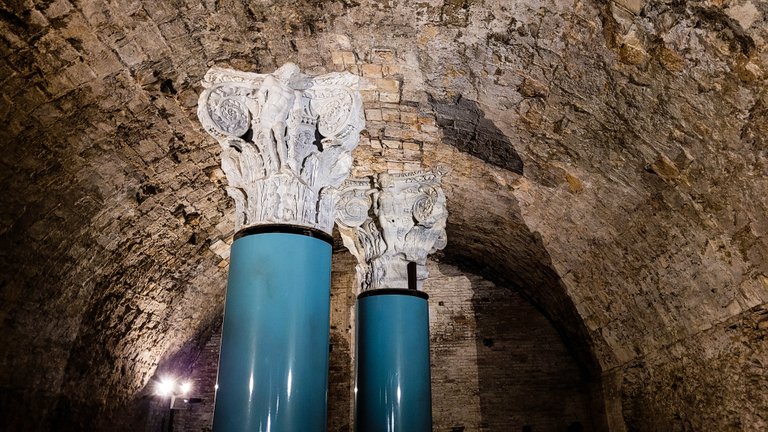





You can also see the chambers where excavations are still being carried out today. I wonder what else is still being found and discovered today!
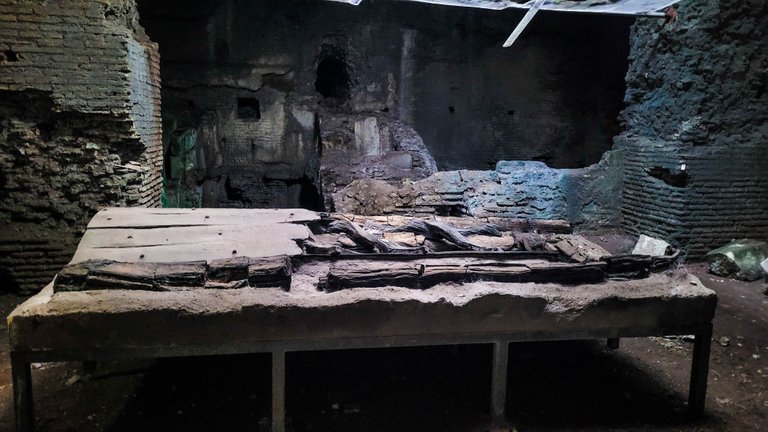
You won't believe it, but down here I came across a huge apple made of white marble. The sculpture is the work of the Italian sculptor Pistoletto. As the guide said, the apple symbolises the Third Paradise. The apple is bitten on one side, but re-joined with large stitches to make it whole again.

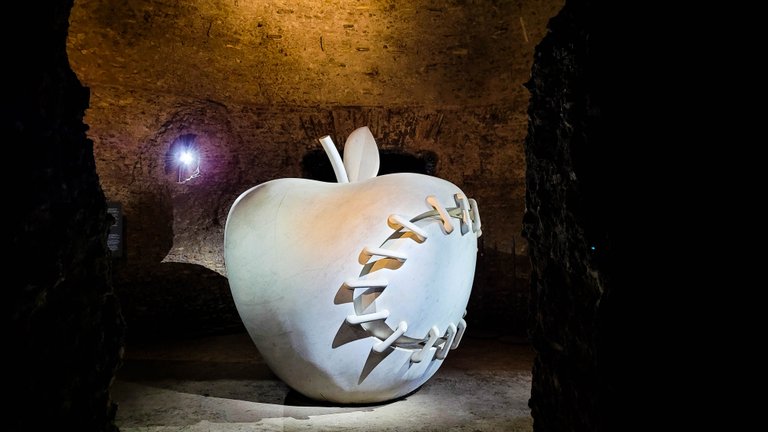

The Mithraeum
Down here, I found a secret that the darkness hides from the sunlight. The mysterious Mithraeum, which was discovered in 1936 during the construction of the new building and has since been restored and opened to the public.


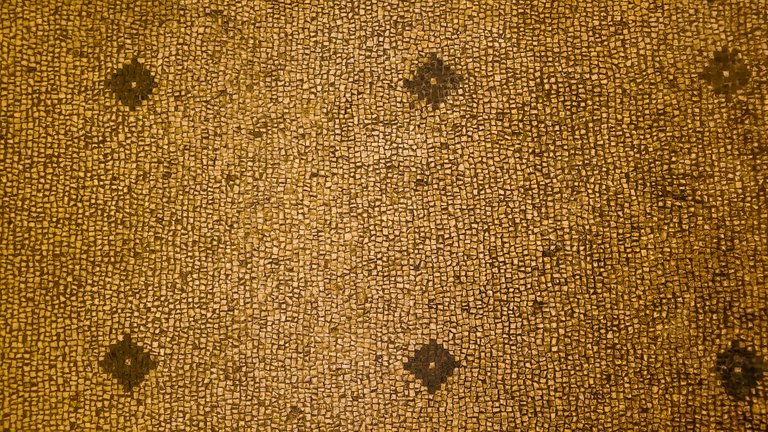
Mithras was one of the many gods that were worshipped in the Roman times. The cult of Mithras, the Persian sun god, began in Persia, but quickly spread throughout the Roman Empire as it became popular with soldiers and other members of military groups.

Inside the Mithraeum there is a marble altar stone on which the rituals were performed. A carved snake is clearly visible on it.


The stone steps on the sides of the room probably served as seats for the participants during the rituals.


As evidenced by the discovery of a large hole, the fossa sanguinis, blood rituals were also performed here. The fossa sanguinis was used to drain blood during the ritual of scarifying a bull. Mithras was famous for its fight against the bull, which symbolised the victory over darkness and death and the birth of new life. Christianity developed a resistance to the cult of the god Mithras, as he was perceived as a competitor. The rituals of this cult were shrouded in secrecy and little is known about them today.


Outside the walls
The tour of the underground part of the baths gave me a great inside of “behind the scene” of this great spa complex. Back at the daylight, through a second exit just in front of imposing walls, I had with a magnificent view of the park and a huge Roman pine tree, typical tree of Rome.

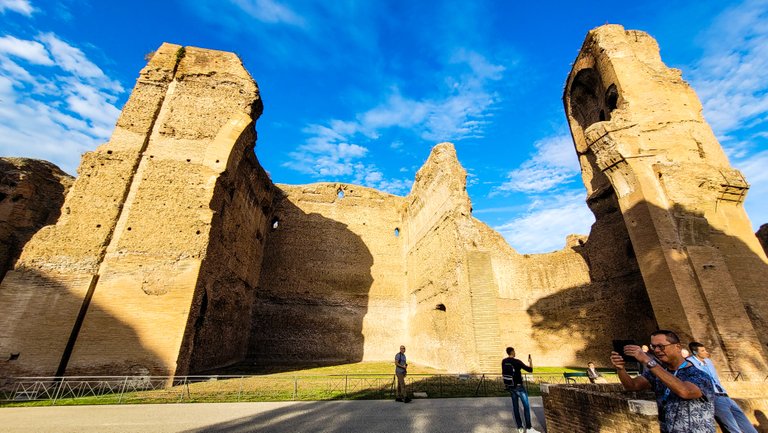
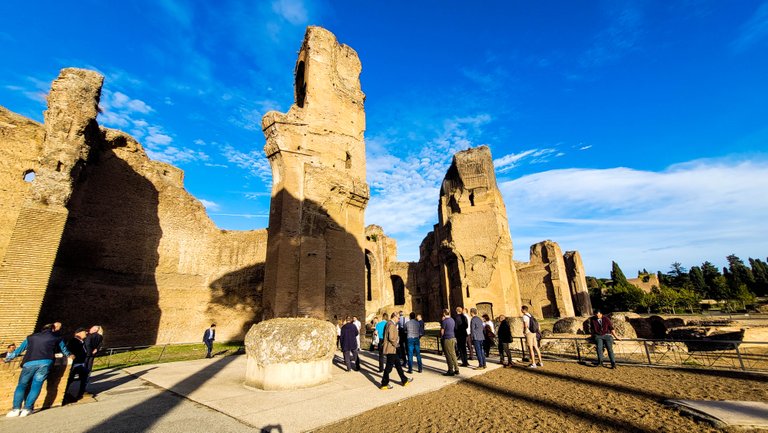

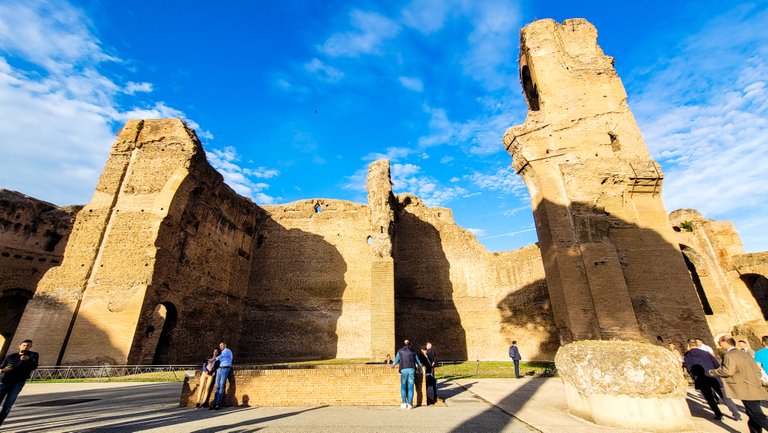





The whole complex included not only a baths, but also two libraries, gyms, changing rooms and a park. The baths themselves were very impressive, covering a large area, and consisting of numerous pools, saunas, massage rooms and changing rooms. The main areas of the baths were the calidarium, a room for hot water and steam baths, the tepidarium, a room for moderately hot passages, the frigidarium, a room for invigorating cold-water baths, and a pool called the natatioio.
Inside the walls
The path led me around the walls, where I found myself in front of the entrance leading towards the frigidarium.



The facade and its details are preserved and clearly visible.






A gym and changing rooms used to be on this site. On the floor, the remains of the pillars that once supported the gym can be seen.


Breath-taking patterns in floor mosaics
The walls and floors of the rooms were completely covered with precious marble, frescoes and mosaics. The intricate mosaic patterns of the floors testify to the skill of the ancient Roman artists.
And you can't miss the beautiful floor mosaic that has been here for almost two millennia. The mosaic is made of stones of different colours, forming unique patterns, truly stunning!







I continued my tour along the marked path and again came across the superbly preserved floor mosaics, this time in different patterns and colours. I guess they were not created by the same artist as the first ones, what do you think?



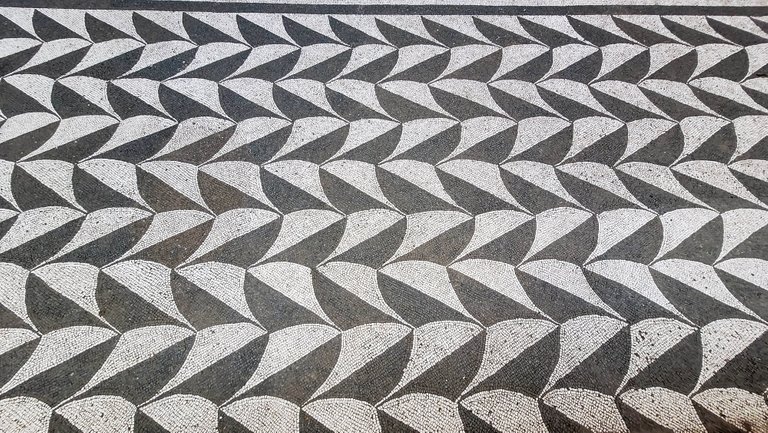
Deep inside the complex
As I continued my journey into the interior of the complex, I couldn't stop looking around me, the remains of the thermal baths are stunning. Even though they are only ruins, with a little imagination you can imagine the wonderful scenes and guess what it was like to stand on this spot almost two millennia ago.













The timeless exhibition
Where the natatio (swimming pool) used to be, there is now an exhibition by the Italian sculptor Penone, named "Ideas in stone", which is set up as a permanent exhibition. The sculptures of the featured trees grow out of stones, and not only that, there are even stones placed on top of them. I wonder what the artist wanted to say? Maybe something about the interconnection between nature and time,...







Mosaics that tell a story
I was surprised and impressed by the huge pieces of mosaics on exhibition here. They have been perfectly preserved and depict a wide variety of motifs from their lives, such as animals, nature or even their gods.

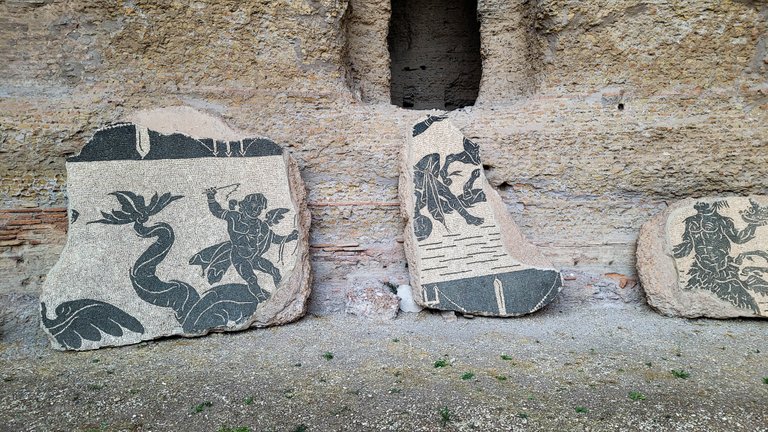
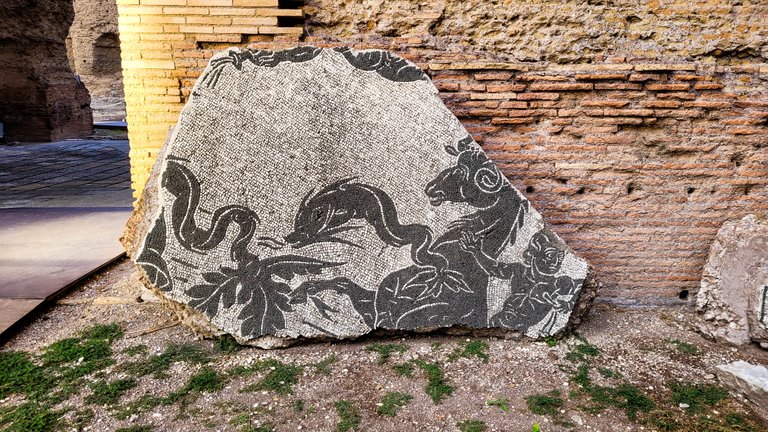



Listen to the story of the frescoes
At the end of my visit, in a separate building, I saw the frescoes on display, which come from a house that was near one of the gyms of the thermal baths. The frescoes depict gods of different cults, proving that the Romans at that time simultaneously worshipped gods of different cults.


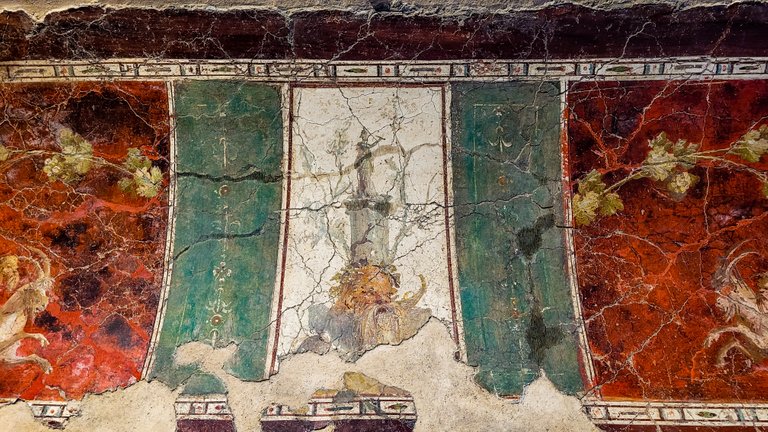

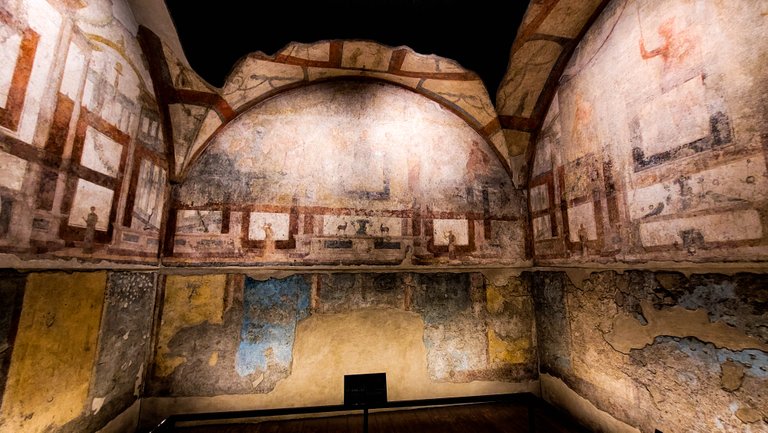

The story must go on
After the fall of the Roman Empire, the marble statues were cut into pieces to make limestone for buildings. The stones and bricks were then recycled to build new structures around Rome.
I found an online video showing a 3D reconstruction of a thermal bath. If you are interested, I would recommend you to watch this video
My today’s story is slowly coming to an end, because you know how it is in life, if something is not finished, something new cannot be born 😊. A visit to the Baths of Caracalla and the Mithraeum is a truly unique experience and they are definitely worth a visit for anyone interested in history, art and architecture. It allows visitors to travel through time and to explore the fascinating world of ancient Rome. The stunning architecture, the magnificent works of art are a testament to the ingenuity and skill of the ancient Romans. The cult of Mithras adds a veil of mystery.
Thanks for reading,
feel free to leave a comment, I will be glad to reply to.
Best regards, @miljo76




